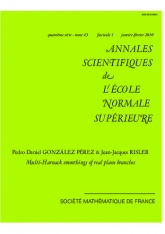Lissages multi-Harnack de branches planes réelles
Multi-Harnack smoothings of real plane branches

- Consulter un extrait
- Année : 2010
- Fascicule : 1
- Tome : 43
- Format : Électronique
- Langue de l'ouvrage :
Anglais - Class. Math. : 14P25; 14H20 , 14M25
- Pages : 143-183
Soit $\Delta \subset \mathbf R ^2$ un polygone convexe à sommets entiers ; G. Mikhalkin a défini les « courbes de Harnack » (définies par un polynôme de support contenu dans $\Delta $ et plongées dans la surface torique correspondante) et montré leur existence (via la « méthode du patchwork de Viro ») ainsi que l'unicité de leur type topologique plongé (qui est determiné par $\Delta $). Le but de cet article est de montrer un résultat analogue pour la lissification (smoothing) d'un germe de branche réelle plane $(C,O)$ analytique réelle. On définit pour cela une e de smoothings dite « Multi-Harnack » à l'aide de la résolution des singularités constituée d'une suite de $g$ éclatements toriques, si $g$ est le nombre de paires de Puiseux de la branche $(C,O)$. Un smoothing multi-Harnack est réalisé de la manière suivante : à chaque étape de la résolution (en commençant par la dernière) et de manière successive, un smoothing « De Harnack » (au sens de Mikhalkin) intermédiaire est obtenu par la méthode de Viro. On montre alors l'unicité du type topologique de tels smoothings. De plus, on peut supposer ces smoothings « multi-semi-quasi homogènes » ; on montre alors que des propriétés métriques (« multi-taille » des ovales) de tels smoothings sont caractérisées en fonction de la e d'équisingularité de $(C,O)$ et que réciproquement ces tailles caractérisent la e d'équisingularité de la branche.

